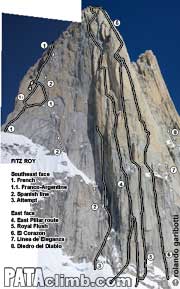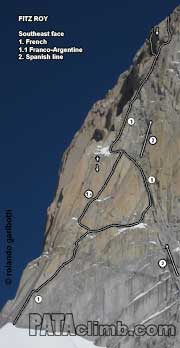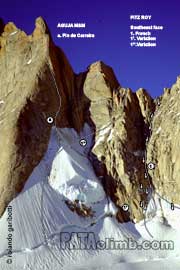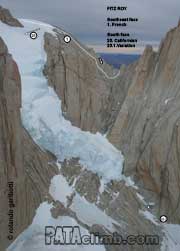Update: last updated on 26/02/2013.
Fitz Roy - Southeast face
1. Francesa
1.1 Franco-Argentina link-up
650m 55° 6a+ A3
Guido Magnone and Lionel Terray (France), 2/2/1952.
Description. The route meanders up the line of least resistance on the right flank of the south buttress. A capable team should be able to climb it in one day from La Brecha. Many sections of this route have been repeated hundreds of times, but it still awaits a complete second ascent!!!
History. This was the first ascent of the peak. Magnone and Terray, with the help of Marc Azéma, Louis Depasse, Rene Ferlet, Louis Lliboutry and Georges Strouvé (France), and Francisco Ibañez (Argentina) fixed ropes on the approach gullies and on the initial 120 meters before completing the ascent in a two-day round trip from La Brecha. Jacques Poincenot was also part of the expedition, but he died before ever setting foot on the mountain while he attempted to cross the Río Fitz Roy. Most of the credit of the first ascent went to the “more famous” Terray, but in fact it was Magnone who “put the hammer down” so to speak, and made the ascent happen. On day two, as clouds rolled in, Terray expressed doubts but Magnone begged him for a “couple more hours” and lead on, climbing the last few pitches as fast as he could and finding a miracle piton at the bottom of their pack. Magnone and Terray tackled the route with a large amount of hardware, pitons mainly, but saved weight by not taking any bivouac gear. They managed to move fast by placing and leaving pitons, without taking the time to remove them. In this way they managed to climb up and down in a short three days. The idea for the expedition was from René Ferlet, after having come across the striking images of Cerro Fitz Roy in De Agostini’s book “Andes Patagonicos”.
Marc Azéma describes in these words the importance of their ascent: “L’événement a détruit toutes les légendes et dépasse tout entendement”, certainly this must have been the impression that Andreas Madsen and some of the other inhabitants of the area had at the time, upon seeing their magnificent peak finally climbed.
Guido Magnone commented on the weather and conditions encountered: “Impressionnés (...) et sous le coup de nos expériences récentes, nous imaginons très bien les difficultés qui nous attendent. Mais la réalité dépassera de loin notre imagination”.
Approach. Laguna de los Tres to Paso Superior to Brecha de los Italianos to La Silla (300m 75˚ -to 90˚- 3),
Descent. The same route, which is the standard descent from the peak.
Bibliography.
Alpinism 99 p.31-32; Alpinism 100 p. 38-50, p. 72; (21); La Montagne 1952/358 p.58-66; Paris Match 164, 3.5.1952; Terray L. (1961) Les conquérants de l’inutile, Gallimard, Paris (p.488-506); Terray L. (1995) Les conquérants de l’inutile, Editions Guérin, Chamonix (p.406-419); Azéma M.A. (1954) La conquéte du Fitz Roy, Flammarion, Paris; L. Depasse (1953) Al Asalto del Fitz Roy, Ediciones Peuser, Buenos Aires; CAB anuario 1953 p.5-11 (Ibañez); Magnone G. (2005) Sculpter de Cimes, Arthaud, Paris (p.95-121); Berge der Welt 7/1952 p.71-78?. AA Lliboutry a.23 #248 p.8-9 1952; a.23 #246 p.3-4 1952.
|
Photos (click to enlarge)

Fitz Roy east face 
Fitz Roy southeast face

Brecha east face

Brecha west face
|
1.1 Franco-Argentina link-up
650m 55° 6c (6a/C1)
Guido Magnone and Lionel Terray (France), 2/2/1952. Alberto Bendinger, Eduardo Brenner, Marcos Couch and Peter Friedrich (Argentina), 10/3/1984.
Description. This is a link-up of the Francesa with a more direct Argentine variation, and is the “normal” route up Fitz Roy. It is a very direct and logical line. The Argentine variation branches off the original Francesa after the third pitch, and follows a steep dihedral, rejoining the first ascent route after five pitches.
From the top of the third pitch of the Francesa climb two mixed pitches up and slightly left, to reach the base of a steep dihedral (2 pitches 5+/A1 or 6b+) leading to “La Araña”, a spider shaped snowfield half way up the southeast face. Continue up for two more pitches, climbing an icy chimney full of loose blocks and a narrow thread of snow to reach the ridge. A few moderate icy pitches give access to the upper headwall. There are a few possible variations in this upper section, all equally difficult. Most parties climb left of a prominent prow, up a steep corner, but it is far far easier to climb to its right following the line climbed by Magnone and Terray. The last 200 meters are not difficult (45°), but require crampons and ice tools.
This route is often climbed in one day from Paso Superior, although unplanned bivies are common. There are many suitable bivouac ledges en route.
History. The first ascent party fixed ropes on the approach gullies and on the first 60 meters. They worked partly as two independent teams, until their final attempt when they decided to join forces. During an early attempt Peter and Alberto managed to reach “La Araña”, but where forced to retreat due to bad weather after a cold bivouac, while Marcos and Eduardo spent hours digging their equipment cache buried under heavy snowfall. During the second ascent, in 1985, Mike Graber, Gallen Rowell and Dave Wilson (USA) made a slight variation, branching left from the original line two-thirds of the way up, following a line that they hoped would be easier, but was not. Solo ascents. Miyazaki Motohiko (Japan), in 12/2/1994 ascended alone, but rappelled with two other climbers. The first unsupported solo was done by Cristoph Hainz (Italy) the 24/12/1994 in only nine hours from base camp. He carried a single 50 meter rope, which he used to self belay on six occasions, three cams, three quickdraws and four nuts. Winter ascent. Paolo Crippa, Dario Sprefacio and Danilo Valescchi (Italy), 5 to 8/8/1988, this was the second winter ascent of the peak. Female ascents. Silvia Fitzpatrick (AR) 1988, many others since. Tina di Batista (SI) and Monika Kambic (AR-SI) first team female ascent of the route and the peak, 2004.
Descent. Rappel anchors are in place along the line of ascent. It is possible to descend this route with a single rope, but it is not recommended.
Bibliography.
First ascent: Desnivel 14 p. 48-51 and great documentary video here.
Rowell: AAJ 1986 p. 97-100
Motohiko: High 142 p. 41.
Hainz: AAJ 1996 p.237; High 152 p. 14.
Crippa: Revista della Montagna 108. |
Please Do Not Reprint This Article.
This article is copyrighted. Please do not reprint this article in whole or part, in any form, without obtaining written permission.
Feedback.
if you find any mistakes or if you have additional information, please go to the contact page and let us know. |
Cerro Fitz RoySoutheast face1. Francesa 1.1 Franco-Argentina link-up 2. Línea Hermanos Gallego 3. Nott-Reichert attempt28. Un Mar de Sueños East face 4. Pilar Este 5. Royal Flush 6. El Corazón 7. Línea de Eleganza 8. Hudičeva Zajeda - Diedro del Diablo Goretta (north) pillar 30. The Real Kekec9. Casarotto 9.1 Diedro Directo 9.2 Kearney-Knight 9.3 Chimichurri y Tortas Fritas9.4 Lindblade-Whimp 9.5 Gringos Perdidos9.6 Acceso Oeste9.7 Crux del Sur9.8 Amaro Vecchia Romana10. Mate, Porro y Todo lo Demás10.1 Guasos on the Rock27. Al Abordaje! North face 11. Polaca 12. Francesa Cara Norte 13. Clínica de Aventura29. Samba do Leao14. Tehuelche 14.1 The Hoser Chimney 15. El Flaco con Domingo 31. Persiguiendo el Avión16. Pretty Bird West face 17. Filo Noroeste, Afanassieff 17.1 Los Últimos Días del Paraíso17.2 Le Chercheur d'Absolu 17.3 Attempt 17.4 Rocamora-Tarditti 17.5 Tango Libre 18. Supercanaleta 18.2 No Brain, No Pain 19. Ensueño20. Historia sin Fin Southwest face 21. Eslovaca 22. Tonta SuerteSouth face 23. Californiana23.2 Variante Suiza23.3 Variante Chilota32. The Washington Route
33. The Colorado Route
34. Asado
24. The Canadian Route 25. Boris Simoncic 26. Anglo-AmericanaTraversesTravesía del Fitz Travesía Care Bear The Wave Effect link-upNorth Pillar Sit Start link-up
|



